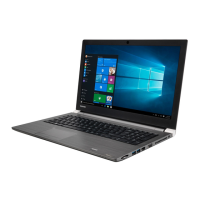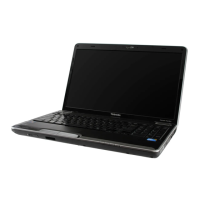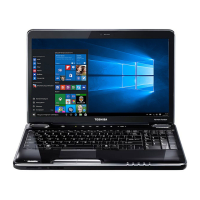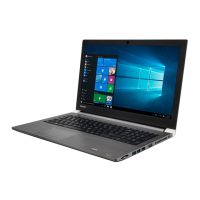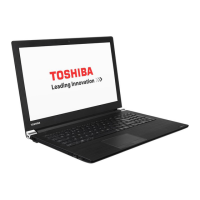
Do you have a question about the Toshiba Satellite A505 and is the answer not in the manual?
| Operating System | Windows 7 Home Premium |
|---|---|
| Storage | 500GB HDD |
| Graphics | Intel HD Graphics |
| Optical Drive | DVD SuperMulti drive |
| Wireless | Wi-Fi (802.11b/g/n) |
| Battery | 6-cell lithium-ion |
| Processor | Intel Core i5 |
Details critical safety measures and warnings for handling electronic components and the computer.
Provides a comprehensive overview of the computer's hardware capabilities and specifications.
Details the various internal components and their functions within the system unit.
Describes the specifications and capabilities of the 2.5-inch Hard Disk Drive.
Outlines the specifications and features of the Solid State Drive.
Details the functionality and specifications of the DVD Super Multi drive.
Explains the functions and operation of the computer's power supply unit.
Covers the types, specifications, and charging control of the computer's batteries.
Introduces the chapter's scope, covering fault diagnosis procedures for FRUs.
Presents a diagnostic flowchart to identify potentially faulty FRUs and guides troubleshooting steps.
Provides troubleshooting procedures for power supply-related issues using LEDs.
Offers troubleshooting steps for system board defects via message and test checks.
Details troubleshooting procedures for HDD malfunctions, including message, partition, and format checks.
Outlines troubleshooting steps for SSD issues, focusing on test programs and connector checks.
Provides troubleshooting methods for keyboard defects, including test programs and connector checks.
Guides users through troubleshooting display problems using external monitors and tests.
Presents troubleshooting steps for ODD issues, including cleaning, testing, and connector checks.
Details troubleshooting procedures for LAN malfunctions, covering test programs and connector checks.
Offers troubleshooting steps for Finger Print reader issues via test programs and connector checks.
Outlines troubleshooting for audio system problems through test programs and connector checks.
Provides troubleshooting steps for IEEE 1394 interface issues via test programs and connector checks.
Details troubleshooting for cooling module problems through test programs and connector checks.
Introduces diagnostic programs, classifying them into OPTION and DIAGNOSTIC TEST types.
Explains how to run diagnostic tests efficiently, covering various test items and their procedures.
Describes how to configure batch parameters, test items, and LOG file settings for diagnostics.
Lists and categorizes various subtests available for diagnosing hardware components.
Details the system test procedures for CPU, Boards, and FAN, including parameter settings.
Covers memory testing procedures, including BIOS ROM, Parity, and Pattern tests.
Explains diagnostic tests for HDD and ODD, including Read/Write, Seek, and Controller tests.
Details video testing procedures for Text Mode, VGA Modes, and VESA Video Memory.
Covers diagnostic tests for LAN Card and 1394 interfaces, including ID and GUID detection.
Outlines diagnostic tests for Keyboard, Mouse, and LED components.
Provides a reference for error codes, their descriptions, causes, and actions for various devices.
Lists quick test items for various devices with their estimated test duration or comments.
Explains how to disassemble and replace FRUs, including safety and general procedures.
Details the procedures for removing and installing battery packs, PC cards, and bridge media.
Provides step-by-step instructions for removing and installing memory modules.
Outlines the procedures for removing and installing the Hard Disk Drive.
Details the removal and installation of the ODD bay module and its components.
Provides instructions for removing and installing the keyboard assembly.
Details the procedures for removing and installing the wireless LAN card.
Guides users through the process of removing and installing the computer's top cover.
Outlines the steps for removing and installing the MDC (Modem Daughter Card) module.
Provides instructions for removing and installing the FM module.
Details the procedures for removing and installing the Bluetooth module.
Provides instructions for removing and installing the system speakers.
Outlines the procedures for removing and installing the display assembly.
Details the removal and installation of various cables, including DC-IN, RJ11, and USB.
Provides instructions for removing and installing the LED board.
Outlines the procedures for removing and installing the system board.
Details the removal and installation of the VGA board.
Provides instructions for removing and installing the CPU cooling module and fan.
Outlines the procedures for removing and installing the CPU.
Details the removal and installation of the Solid State Drive (SSD).
Provides instructions for removing and installing the slot ODD module.
Outlines the procedures for removing and installing the display mask.
Details the removal and installation of the FL inverter board.
Provides instructions for removing and installing the LCD module.
Outlines the procedures for removing and installing the CCD board and microphone.
Details the removal and installation of power, switch, and logo LED boards.
Provides instructions for removing and installing the button board.
Provides precautions and guidelines for safely handling the LCD module.
Shows diagrams of the system board's front and back views with component layouts.
Lists pin assignments for various connectors on the system board and other modules.
Details keyboard scan codes and character mappings for different key states and modes.
Illustrates the key layouts for various international keyboard configurations.
